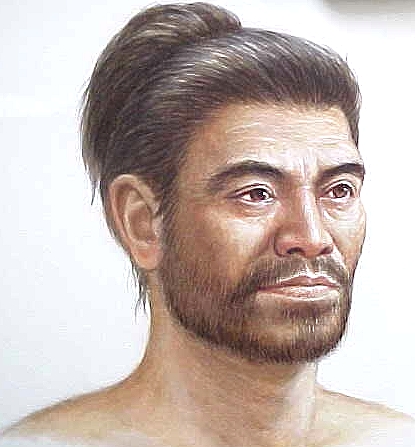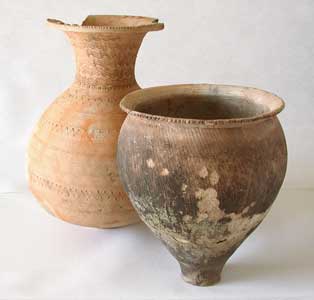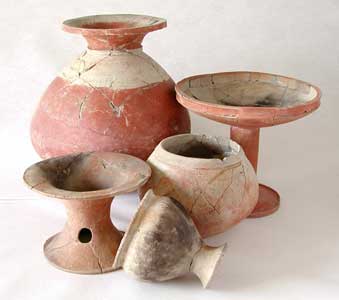Hello
Today I
would like to speak of early history of Japan
Mainly of
Jomon and Yayoi epoch
It’s
possible that we have not enough time to talk of all points so it this talk
probably gonna be continued
We can
speak of Japan as archipelago only since the end of last glacial period (about
13000 BC)
While
during glacial Japanese archipelago was connected with continent in the
following way:
In the time
of glacial first people of modern anthropology type came to this territory. These
people were direct ancestors of modern/historical Ainu and they set the culture
which later was named Jomon.
This archaeological culture
or a group of cultures existed in Japanese archipelago since about 13000 BC
till about 500 BC.)
Jomon is Japanese calque of English term 'cord mark', 'cord marked
pottery' which describes a characteristic feature of the pottery of this
archaeological culture and on which this culture or a group of cultures was
named.
Jomon pottery is the oldest pottery of the world and one of the most
beautiful also:
There were different types
of ceramics and the most interesting was made by the late of Jomon.
Among Jomon ceramic
artifacts the most interesting are so called dogū - clay figurines of unknown means:
some anthropologists suppose that these dogu can be substitutes of human sacrifice and
are somwhow realted to Ainu inaw http://tresi-nonno.blogspot.com/2012/06/basic-concepts-of-ainu-religion-and.html . Anyway it is possible to
state that they could have some relation to creeds of Jomon people.
The proves
of Ainu and Jomon people relationship are the following:
a reconstruction of Jomon
man (proves of the fact that people of Jomon were of Ainu origin are the
following: similarity of Ainu skulls and Jomon skulls:
then are
founded many localities where sites of Jomon epoch are found bearing names traceable to Ainu roots, we can
only assume that persons using the same language as the Ainu were formerly
established in such places. http://tresi-nonno.blogspot.com/2011/12/ainu-jomon-relationship-prooves-by-neil.html
(we should use term Jomon with certain degree
of awareness cause it is just a term invented to designate a complex of
archaeological cultures but later it was used by some Japanese anthropologists
in order to artificially distinguish Ainu culture from its roots)
People of
Jomon epoch were seagatherers, forest gatherers, fishers, forest hunters and
sea hunters and didn't practise agriculture so a vast space of wild nature was
a matter of high importance for existence of their culture.
(Basic
economical articles of Neolithic Ainu were gathering of shells and gathering of
chestnuts and nuts. Jomon archaeological culture is famous by its shellheaps.
And so Neolithic Ainu were basically closely connected with forests of
chestnuts and nuts which covered then most part of Japanese archipelago)
Thus people
of Jomon never had any big settlements, the biggest social unit was local group.
To maintain balance in nature and in
human population was matter of vital importance for such culture.
Because of
it they settled all over archipelago from southern Ryukyu till Hokkaido and
also Kuril islands and southern half of Sakhalin and southern end of Kamchatka:
Toponyms of Ainu origin corroborate this fact, for example: Tsushima <- Ainu.: tuyma – "distant", Fuji <- Ainu: huci – "grandma", "kamuy of fireplace"; Tsukuba <- Ainu: tu ku pa – "head of two bows", Yamatai <- Ainu: ya ma ta i – “place where harbour deeply cuts the land”, many examples of Ainu toponyms can be found in Kindaichi Kyousuke works.
About the
mid of Jomon period some groups of Austronesian people from South-East Asia
appeared in the southern part of Japanese archipelago.
(This group
is named austronesian with a certain degree of conventionalism because there
could be also some people of Yue and Hmong-Mien. And it is important to note
that we have little information of this group.)
This new
migration destroyed the balance of nature and some groups of Ainu were forced
to move northward/ Ainu migration to the island of Sakhalin, the islands of
Kuriles and Kamchatka began.
When Ainu moved northward they influenced strongly on the culture of Nivkh, Itelmen and Oroch. This fact had been reflected by language: for example: Ainu word kotan – "settlement", "inhabited area" exists in Old Mongolian as gotan, in the language of Gold – hoton, in Manchurian language – hotan, in Nivkh language – hoton.
Or, for
example, Ainu word inaw, designating little baton with shavings –
one of the most important objects of Ainu religion, exists in Nivkh language – nau,
in Oroch language – ilau.
In Itelmen
language exists word kamul designating spirits living in volcanoes and
geysers, I believe that this word originated from Ainu word kamuy –
“super human being”.
I think
that it is possible to speak about Ainu colonization because in Ainu language
exists original not borrowed word for expression of modality “should”, “must” –
easirki- “do to do first of all”
while such a languages as Nivkh,
Itelmen, Oroch use borrowed words to express this modality and originally have
just two modalities: “want” and “cannot”. Modality of “should” is a
marker of high organized social system.
While some
groups of Ainu were moving northward in the southern part of Japanese
archipelago appeared some ethnic groups from Korea.
These
migrants were of Mongoloid anthropological type and spoke an Altaic language.
First groups of this migration appeared in Japanese archipelago in the end of
Jomon and in the beginning of Yayoi epoch.
Comparison
of anthropological type of Jomon/Ainu and newcomers of Yayoi:
(Yayoi is archaeological culture which came in
the stead of Jomon. It is also named
after its ceramics which was named after teh place where it was found - Yayoi
district in Tokyo. Yayoi culture lasted from 500 BC till about 300 AD).
And the
last groups of these ancient Korean migrants appeared in the Japanese islands
in the very end of Yayoi and even in the beginning of the next period – Kofun –
“Burial mounds period”.
It is
generally supposed that this last group was the root of emperor kin tenno and
established Yamato state and that after the establish of Yamato began the epoch
of permanent war between Wajin(Japanese) and Emishi(Ainu). But reality
was a bit more difficult.
First, word Yamato obviously originated
from word Yamatai. (Yamatai is the most ancient state placed in the Japanese archipelago.
Yamatai state was described in Chinese chronicle "Wei Zhi".
Yamatai
state was described in Chinese chronicle "Wei Zhi". We are to note
that Wei Zhi is allocated against others Chinese text of this epoch: it has no
fantasy and it's very realistic, for example distance between Korean peninsula
and Yamatai is described very close to reality. "Wei Zhi" is jut a
diary of a traveller. And there are a lot of Ainu toponyms and names in it, for
example Pimiko queen of Yamatai is a name of Ainu origin, originally it was Pi
mik kur - Person who solves problems and barks)
Word
"Yamato" is written down by hieroglyfes as 大和 and according to the rules these
kanji should be read as 'dai wa' - 'great wa'. ("Great Wa" is the
name invented by Chinese to denote ancient Japan and it was used until term
Nihon was invented.)
But they
are not read so, they are read 'Yamato', so I am to note that reading of these
kanji as "Yamato" isn't even ateji (meaningless kanji which express
the phonetics) but is just a reading which is attached to these kanji. This
fact tells us that word Yamato is of island origin. Moreover I state that
Yamatai/Yamato is a word of Ainu origin.
(Yamato is just a transformation of Yamatai
cause in Old Japanese diphtongs were not allowed and they became a single
soud.)
The word
Yamatai definitely consists of clear Ainu roots and has clear meaning if it is
read in Ainu (this toponym describing a characteristic feature of a certain
local landscape as well as all Ainu toponyms): ya ma ta i - "place
where hardour deeply cuts the land".
(In Wei Zhi
word Yamatai is written down as ateji i.e. using some meaningless hieroglyphes
which express phonetics, here 邪馬台 so it is possible to restore phonetics)
The most probable place where Yamatai state could be is a harbour in the mouth of Chikugo river near of the town with the same name (i.e. Yamato) in Fukuoka prefecture in the island of Kyushu.
All these
facts are well described in book "Wei Zhi read via Ainu language" by
Hashimoto Kiyoshi who though is an amateur and despite of he made some mistakes
but his general ideas are definetily true and shoul be paid attention for.
Having
analysed Wei Zhi Hashimoto defined the place of Yamatai as it's shown in the
following schemes:
There was
appropriate material base for appearing of a state, though agriculture which
usually is the precondition for appear of statehood, was practised restrictedly
by the Ainu of late Jomon, but rich sea hunting sea fishing and sea gathering
definitely could be the base of material stratification and statehood.
“Jomon
people occasionally diverted axes for cutting down trees and bows and arrows
for hunting to the purpose of killing people, but the number of such victims
was very small; among several thousand bodies of Jomon people so far
discovered, less than ten bodies (!) were the victims of homicide.
On the other hand, the evidence of warfare during the Yayoi Period is quite clear. Defencive settlements appeared, which were surrounded by either moats of defensive walls or which were located on the hilltops characterized by poor productivity but by excellent command of view.
An
extensive defensive moat and a watch tower are exemplified by the recent
discovery of the Yoshinogari settlement site (dated to the first to third century.
A. D.) in Saga Prefecture, western Kyushu Island.
While no homicide tools per se in the Jomon Period, there were many kinds made of bronze, iron, and stones used in the Yayoi Period. Among these, the evolution of stone arrowheads in western Japan tends to illustrate this transformation from a peaceful Jomon community to an aggressive Yayoi village.
While no homicide tools per se in the Jomon Period, there were many kinds made of bronze, iron, and stones used in the Yayoi Period. Among these, the evolution of stone arrowheads in western Japan tends to illustrate this transformation from a peaceful Jomon community to an aggressive Yayoi village.
For ten
thousand years since the beginning of Jomon Period, the form of arrowheads was
triangular, and the arrowheads weighted less than two grams. The lighter an
arrow was, the further and faster the arrow flew. On the other hand, the
heavier an arrow, the deeper the arrow could penetrate into the prey's or
victim's body.
...Archaeologistss have also discovered many Yayoi Period tombs for the victims against whom such homicide tools were used or those un which such homicide tools were buried with the bodies...”
Research of
DNA of Japanese population showed that most widely spread Y-japlogroup is D2
which is main Ainu Y-haplogroup (about 86% of Ainu have it). The most notable
fact is that Japanese and Korean have similar mtDNA while Korean have
practically no Y-DNA D2. That means that Ainu took Korean women but not vice
versa. This fact tells us that the rulers were Ainu.
But how it could be? From a common point of view Japanese culture has practically no similarities with Ainu culture. (Though as it will be shown in special text the roots of Japanese culture are of Ainu origin) Japanese speak Japanese language but not Ainu. Below I try to explain how it could be.
When in the beginning of Yayoi epoch in Japanese archipelago started to appear first groups of Korean newcomers the archipelago is completely occupied by Ainu and there are almost no free territories and no newcomers are desirable. There are some groups of Ainu, some principalities which wage war between each other and safety of Korean newcomers is quite questionable.
This
because the first newcomers from Korea set themselves in those territories
which are close to Korean peninsula: in North-West of Kyushu and in Izumo.
With the
arrival of Korean newcomers social tension and opposition not only between
islanders and newcomers but also between various groups of Ainu and newly
arrived Koreans and, it is probable somehow to strengthen the position of their
clans Korean leaders decided to enter the relations with leaders of the most
powerful Ainu clans.
Just let's image the following situation: Korean
chief has a daughter and he made her to marry the chief of most powerful Ainu
clan which is Yamatai clan. The "Korean" leader counts that his
son-in-law will battle for his clan against other Ainu group and other
"Koreans".
The Ainu leader also has his interests: first, strangers with whom it is going to become related, brought such technologies, possessing which, he can subdue hostile Ainu groups almost without any efforts; besides, the fact of possession the foreign woman also will lift his prestige and prestige of his clan in eyes of another groups of Ainu.
And thus
the most brutal Ainu leader takes as wife the most beautiful and educated
«Korean princess». They give birth to a boy who gets the "Korean"
education, learns to be at war at the father and inherits to the grandfather –
becomes head of the "Korean" clan, but he bears Ainu Y-haplogroup.
And one of such sons of the Ainu chief and "Korean princess" became the ancestor of a clan which later was called tenno.
And one of such sons of the Ainu chief and "Korean princess" became the ancestor of a clan which later was called tenno.
In other
words these people were Ainu by their blood but under the influnce of Koreans
they actively boorowed/accepted continental cultures.
Thus
Japanese ethnicity was formed, so Japanese are just mixture of Ainu and Austronesian
and Korean. And Japanese language is just a creol formed on the base of Old
Korean.
Anyway it is just the general outline of the story about how Yamatay became Yamato.
Moreover it should be noted that from the very beginning there were very different groups of Ainu: certain groups created state structures and certain didn't. It is highly probable that those Ainu who later fought with Yamato state were considered as savages even by the people of Yamatai.
Anyway it is just the general outline of the story about how Yamatay became Yamato.
Moreover it should be noted that from the very beginning there were very different groups of Ainu: certain groups created state structures and certain didn't. It is highly probable that those Ainu who later fought with Yamato state were considered as savages even by the people of Yamatai.
Also it highly
possible that there were several Ainu states and that kingdom/principality of
Yamatai subdued those which were more weak.
Also it should be noted that even early Yamatai was very different in its ethnic aspect. From the very beginning there were not only Ainu but also Austronesian and possibly some Korean and Chinese (Korean and Chinese could be on service of prices of Yamatai as ambassadors of Yamatai to Han and Wei)
Also it should be noted that even early Yamatai was very different in its ethnic aspect. From the very beginning there were not only Ainu but also Austronesian and possibly some Korean and Chinese (Korean and Chinese could be on service of prices of Yamatai as ambassadors of Yamatai to Han and Wei)













0 件のコメント:
コメントを投稿